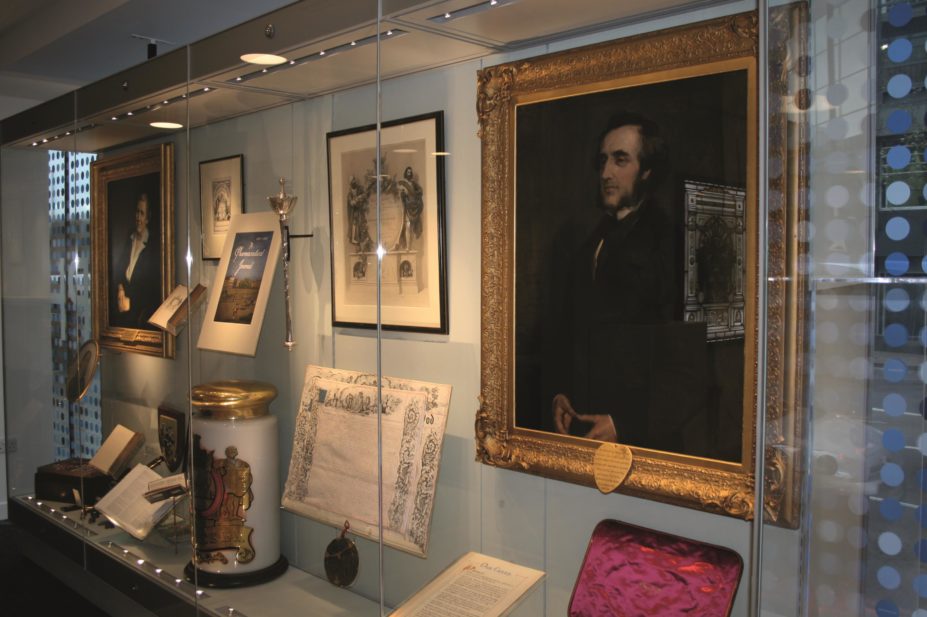
RPS / MAG
Walking through the glass doors of the Royal Pharmaceutical Society (RPS) in East Smithfield you are greeted with rows of stunning blue and white, tin-glazed delftware apothecary jars and intricately decorated bell metal mortars.
Often overshadowed in other museums, at the RPS the delftware collection is proudly displayed, as it would have been in apothecary windows during the 17th and 18th centuries. Apothecary jars, which were used to store medicinal ingredients and preparations, would have been seen as an indication of an individual’s position in the profession.
This impressive display is just a preview of the extensive collection in the RPS museum, which has more than 45,000 items to its name.
History of the museum
The museum was originally established in 1842, a year after the Society was founded by Jacob Bell. In the first edition of The Pharmaceutical Journal, Bell wrote that the RPS should have a “complete museum of materia medica comprising specimens of good and bad drugs”.
John Betts has been the keeper of the museum collections at the RPS since 2012. He says the role of the museum has changed dramatically since the end of the 19th century and points out that it was originally never intended for housing historical material.
“Initially, the museum was solely a teaching collection for pharmacy students to help them identify specimens for exams. People sent in plant samples from around the world – barks, roots. It was a comprehensive collection of what would be used in medicines at the time,” says Betts.
Theophilus Redwood was the first museum curator of the RPS — along with many other titles to his name, including professor of pharmacy, librarian and joint editor of The Pharmaceutical Journal. By 1863, donations from society members and pharmaceutical businesses had enabled the museum to expand into three rooms.
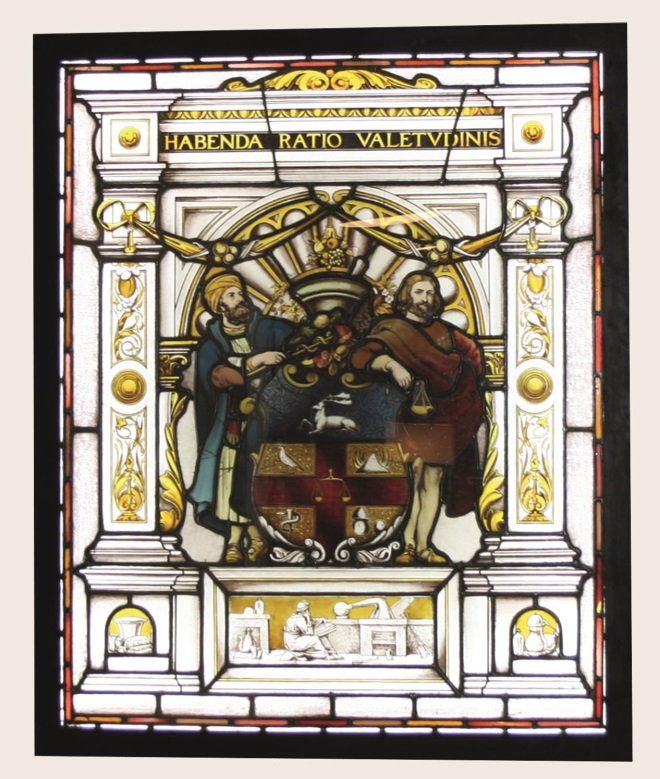
Source: Museum of the Royal Pharmaceutical Society
The Royal Pharmaceutical Society’s arms, crest and motto depicted on a stained glass panel, probably dating from 1910
At this time, the museum was used mainly as a source of specimens for lectures given at the school of pharmacy in Bloomsbury Square, London. It wasn’t until 1937 when the Society was planning to move to a new headquarters that the collecting policy of the museum started to change. Although the move was eventually abandoned, the arrival of pharmaceutical chemist and keen-eyed curator Agnes Lothian in 1940 led to a vast expansion and development of the collection. She ambitiously set to gathering historical mortars, proprietary medicines, medicine-making equipment, and the all-important English delftware jars, on which she authored a number of articles.
“It became a much broader collection that represented the wider world of pharmacy. Objects related to all aspects of British pharmacy, rather than just teaching,” explains Betts.
In 1977, after 136 years at Bloomsbury Square, the Society moved to Lambeth where the museum’s collections were displayed throughout the five-floor building at 1 Lambeth High Street. In 2013, the RPS discovered that artefacts, including irreplaceable cups, medals and items dating back to Georgian times, had been stolen from the collection. A police investigation was launched and the RPS implemented a number of recommendations for enhanced security. In 2015, the collection was moved again to the current RPS residence in East Smithfield.
On the move
Preparations for the most recent move began two years ahead in the summer of 2013. Before moving any of the objects to East Smithfield, a full photographic catalogue of every artefact was needed, a job that fell to the museum collection assistant as well as a number of museum volunteers.
The catalogue is a thorough document containing each item’s individual catalogue number, a brief description, measurements, colour, material, who made it, who donated it and where it is located.
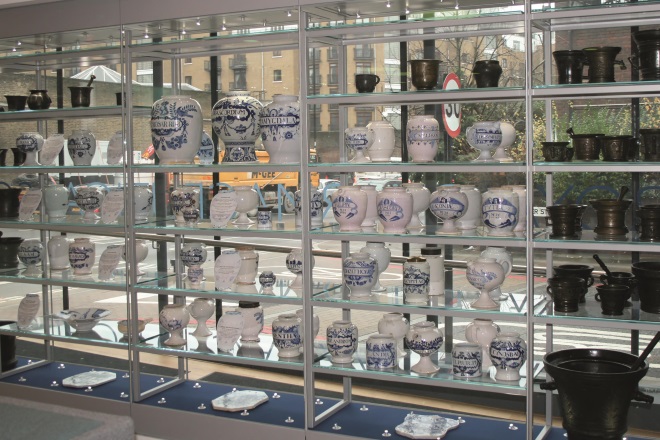
Source: Museum of the Royal Pharmaceutical Society
The collection of tin-glazed delftware apothecary jars and bell metal mortars at the entrance of the Royal Pharmaceutical Society in London
In 2005, all the objects were moved to a digitised system and can be tracked via a unique number. Betts was excited by the opportunity to catalogue the collection as it was a chance to find items that had been hidden away for years: “Having worked here [for] eight years, there’s still things I’ve never seen,” he explains. “I may have seen a photo but it’s nice to get the catalogue out and have a chance to see it.”
Without space to house the full collection, many larger pieces have been stored offsite in a secure facility since 2002, entry to which is limited to museum staff. The new RPS building holds around two-thirds of the overall collection.
To prepare the pieces before moving, they were individually bubble-wrapped and liquid medicines were put in resealable bags to protect against spillage. It took 12 days to move all of the objects, with one truck doing shuttle runs back and forth between Lambeth and East Smithfield.
Brand new home
A move to a new home brought a unique opportunity for Betts and his team to re-display the museum collections. One of the main differences about the new headquarters is that the main museum is no longer dotted around on different floors. At the Lambeth site it was necessary for visitors to the museum to pre-book a guided tour, otherwise important objects would be missed.
“[Now it’s] all in one place in a publically accessible location, visitors can see the whole collection — [it’s] a much more cohesive display,” Betts explains. “When you come in, there [is] one big collection that focuses on delftware and metal mortars, looking at objects not just in the context of history but as beautiful objects.”
When asked about the challenges associated with being in charge of such a huge collection of artefacts, Betts says that it is in curating new displays, trying to weave together all aspects of British pharmacy and deciding “how objects work together to get meaning from one another”. For some of the more modern artefacts, the team is still working with external designers to put together the final displays.
Glimpse into the collection
Along with the delftware apothecary collection, which dates back to 1647 and is one of the best in Britain, there are a number of other notable items worth looking out for.
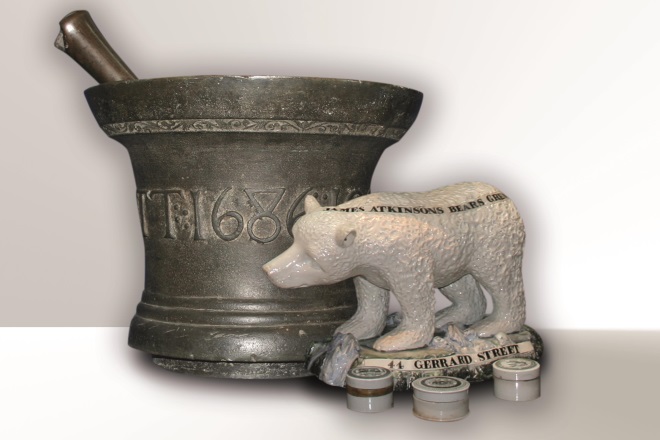
Source: Museum of the Royal Pharmaceutical Society
English bell metal mortar and pestle, dating from 1686 and ceramic creamware polar bear advertising James Atkinson’s Bears Grease
These include a collection of bell metal mortars from around the world. Such mortars have been used for centuries in food and drug preparation, in fact, the pestle and mortar have become defining symbols of the pharmacist and feature on the coat of arms of the RPS.
The most notable bell metal mortars include one belonging to previous RPS president Ernest Saville Peck, which was uncovered during the move to East Smithfield, and one that was used in Louis XIV’s personal apothecary.
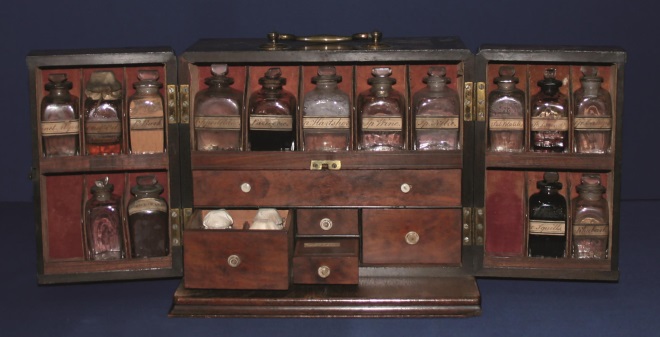
Source: Museum of the Royal Pharmaceutical Society
Early 19th century mahogany medicine chest, housing 15 bottles with handwritten labels
The museum has the most comprehensive collection of medicines in the country, with medicines dating back to the 1700s and still in their original packaging. Some are quack medicines, or even poisons, used at a time when the absence of legal frameworks meant any claim could be made about their effects. Betts explains further: “Often it was just a mild laxative, so [the maker] could prove it did something to you.”
Betts says the museum is still collecting items to ensure the collection is representative of contemporary pharmacy: “We did collect packets of Tamiflu. It represents what happened at the time [of the pandemic].” Other, less recent, medicines are proving more problematic — such as thalidomide, which was used in the 1960s and of which there are no examples of the pure drug in the collection. “Thalidomide led to so many controls — it’s a part of pharmacy history,” says Betts, who would also “love to get some” original early HIV treatments to put into the display. “There are some objects where, if you don’t get it there and then, you won’t [ever] get a contemporaneous example,” he adds.
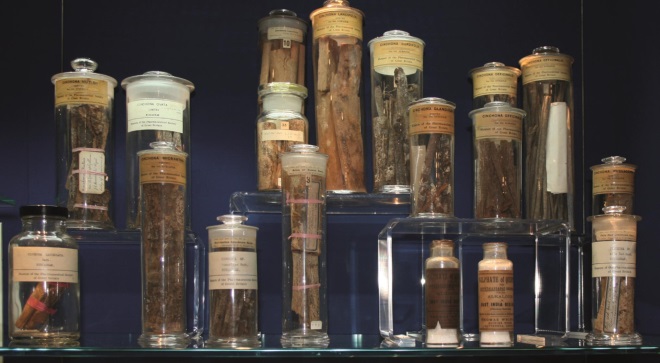
Source: The Museum of the Royal Pharmaceutical Society
Collection of chinchona bark, used to produce quinine
In recent years, the museum has been reliant on donations and around 40 new donations are made each year, often comprising multiple items. Betts asks that potential donors contact the museum first if they think they have an item of historical interest. “We were offered a whole Victorian shop fitting. It would have looked lovely, but it was too big to display. It was mahogany,” he says, clearly still pained by the memory of having to say no.
Beyond the collection
The RPS museum also offers a historical research service for RPS members. Staff help answer queries regarding the identification of pharmacy antiques, the career history of pharmacists and their premises, the history of medicines and treatments, as well as questions about the history of the Society itself.
The museum archives also hold a record of every person practising pharmacy from 1868 until 2010, when the General Pharmaceutical Council (GPhC) took over the Society’s regulatory role. These registers were updated manually and include the home or work address and qualification of each individual.
In addition, the museum has an extensive photo archive comprising more than 3,000 photographs.There are images of William Martindale, a Victorian pharmacist who’s Extra Pharmacopoeia was first published over 130 years ago, and photographs of all the RPS presidents, including Jean Kennedy Irvine, the first female president from the 1940s, Alexander Fleming, who discovered penicillin, and the earliest photograph, taken in the 1840s, of RPS founder Jacob Bell.
Visiting the museum
RPS members are free to come along to see the museum during opening hours and can also pre-book tours run by Betts and his team of volunteers. There are plans for an official public opening in 2016. The RPS is also working on an app for smartphones and tablets that will hold a catalogue of the collection highlights.
But it’s not only pharmacists who will appreciate what the museum has to offer. Around 90% of the museum’s visitors are non-pharmacists: “One art student used delftware to create jars that looked like medical conditions,” explains Betts.
“[Our] primary audience is still pharmacists and [those interested in] pharmacy history. But medicines and health impact everyone. We’re trying to present the museum from the point of view of the patient, how it was to be a patient 200 years ago and how it is now.”
- This article was amended on 5 January 2016. Theophilus Redwood was a joint editor of The Pharmaceutical Journal, not subeditor as previously stated.

